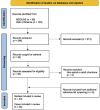Characteristics and survival outcomes in pediatric patients with spinal chordomas: insights from the National Cancer Database and review of the literature
- PMID: 39747717
- PMCID: PMC11937186
- DOI: 10.1007/s11060-024-04921-x
Characteristics and survival outcomes in pediatric patients with spinal chordomas: insights from the National Cancer Database and review of the literature
Abstract
Purpose: Spinal chordomas are aggressive tumors that rarely occur in the pediatric population. Demographics and post-treatment outcomes in this select group of patients is poorly studied. We hence aimed to analyze the clinical characteristics, demographics, and survival outcomes of pediatric patients with spinal chordomas, in contrast to the adult population. To address this, the literature was reviewed to evaluate the coverage on spinal chordomas of the pediatric population, and the National Cancer Database (NCDB) was analyzed to provide insights into the US experience over the past two decades.
Methods: A search of the literature was performed leveraging the MEDLINE and Web of Science electronic databases from inception until March 2024, using the keywords "spinal," "chordoma," and "pediatric". Additionally, the NCDB was queried for pediatric patients (≤ 21 years) with chordoma treated between 2004 and 2017. Baseline characteristics, tumor specifics, treatment details, and survival outcomes were collected and analyzed.
Results: From the literature, 45 pediatric chordoma patients were identified, with a median age of 7 years. Most chordomas were in the cervical spine (40%), and 93% of the patients received surgical treatment. Gross total resection was achieved in 59% of cases, and 49% received adjuvant radiotherapy. Recurrence, metastasis, and mortality rates were 7%, 18%, and 24%, respectively at a median follow-up of 12 months. In the NCDB cohort, 53 pediatric patients (≤ 21 years) and 980 adults (> 21 years) were compared. Despite having smaller tumors in size, pediatric patients presented with more advanced tumors with a higher proportion of stage 4 tumors. They had more mobile spine chordomas (83% vs. 51%) and traveled further for treatment (57 vs. 27 miles). Pediatric patients also received higher radiation doses (5420 vs. 5049 cGy). Surgical resection and adjuvant radiotherapy were common treatments in both groups. After matching, outcomes, including survival rates and early mortality, were similar between age groups. Kaplan-Meier analysis showed no difference in overall survival probabilities between the age groups both prior to and after matching.
Conclusion: While pediatric patients with spinal chordomas present with more advanced stage tumors, they demonstrate similar overall survival outcomes when compared to adults. The current literature is mainly composed of single cases and other reports of low evidence levels.
Keywords: Clinical outcomes; National cancer database; Pediatric; Spinal chordoma.
© 2024. The Author(s).
Conflict of interest statement
Declarations. Competing interests: The authors declare no competing interests.
Figures
Similar articles
-
Impact of proton versus photon adjuvant radiotherapy on overall survival in the management of skull base and spinal chordomas: a National Cancer Database analysis.J Neurosurg. 2024 Aug 23;142(1):239-247. doi: 10.3171/2024.5.JNS24511. Print 2025 Jan 1. J Neurosurg. 2024. PMID: 39178472
-
Survival of patients with malignant primary osseous spinal neoplasms: results from the Surveillance, Epidemiology, and End Results (SEER) database from 1973 to 2003.J Neurosurg Spine. 2011 Feb;14(2):143-50. doi: 10.3171/2010.10.SPINE10189. Epub 2010 Dec 24. J Neurosurg Spine. 2011. PMID: 21184634
-
Analysis of prognostic factors for survival in patients with primary spinal chordoma using the SEER Registry from 1973 to 2014.J Orthop Surg Res. 2018 Apr 6;13(1):76. doi: 10.1186/s13018-018-0784-3. J Orthop Surg Res. 2018. PMID: 29625617 Free PMC article.
-
[Chordoma].Neurochirurgie. 2014 Jun;60(3):63-140. doi: 10.1016/j.neuchi.2014.02.003. Epub 2014 May 23. Neurochirurgie. 2014. PMID: 24856008 Review. French.
-
Surgical Management of Spinal Chordoma: A Systematic Review and Single-Center Experience.World Neurosurg. 2021 Dec;156:e111-e129. doi: 10.1016/j.wneu.2021.09.001. Epub 2021 Sep 22. World Neurosurg. 2021. PMID: 34506978
References
-
- Bakker SH, Jacobs WCH, Pondaag W et al (2018) Chordoma: a systematic review of the epidemiology and clinical prognostic factors predicting progression-free and overall survival. Eur Spine J 27(12):3043–3058 - PubMed
-
- Baig Mirza A, Bartram J, Okasha M et al (2021) Surgical management of spinal chordoma: a systematic review and single-center experience. World Neurosurg 156:e111–e129 - PubMed
-
- Yu X, Kou C, Bai W et al (2020) Comparison of wide margin and inadequate margin for recurrence in Sacral Chordoma: a Meta-analysis. Spine 45(12):814–819 - PubMed
-
- Ghaith AK, Nguyen R, El-Hajj VG et al (2024) Proton versus photon adjuvant radiotherapy: a multicenter comparative evaluation of recurrence following spinal chordoma resection. Neurosurg Focus 56(5):E9 - PubMed
Publication types
MeSH terms
LinkOut - more resources
Full Text Sources
Miscellaneous



